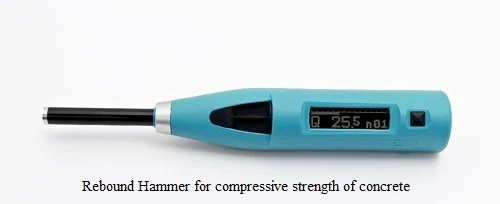In this blog I have explained about Rebound Hammer Test for concrete, which is a non destructive test (NDT).
By the help
of this blog you can easily find the compressive strength of concrete
by using the rebound hammer test for concrete. So please
continue to the end & keep your love and support on me.
What is the Rebound Hammer Test ?
Rebound Hammer test is a Non-destructive testing method
of concrete to find out the compressive strength of concrete using the Rebound
Hammer as per IS : 13311 : 1992 (PART– 02). This test provides a convenient and
rapid indication.
Rebound Hammer Test on Concrete Surface | Schmidt Hammer Test | Concrete Non Destructive Test
Principal of the Rebound Hammer Test :-
The rebound
number of an elastic mass depends on the hardness of the surface against
which its mass strikes.
Apparatus Required For The Test:-
- Rebound Hammer instrument.
- Abrasive Stone
IS Code for Rebound Hammer Test on Concrete Surface :-
- IS:13311:1992 (PART – 02)
- Hold the instrument firmly so that the plunger is perpendicular to the test surface.
- Gradually push the instrument toward the test surface until the hammer impacts. After impact, maintain pressure on the instrument and if necessary depress the button on the side of the instrument to lock the plunger in its retracted position.
- Read the rebound number on the scale to the nearest whole number and record the rebound number. Take ten readings from each test area. No two impact tests shall be closer together than 25 mm (1 in).
- Examine the impression made on the surface after impact, and if the impact crushes or breaks through a near-surface air void, disregard the reading and take another reading.
 |
| Reading Your Results:- |
- Make at least ten readings from a concrete surface and discard the highest and lowest rebound numbers.
- Average the remaining eight numbers. If desired, take a few test readings before you complete your series of ten regular tests.
- Use the average rebound number to estimate the strength of the concrete.
- Compare your average rebound number to the chart shown on your Concrete Rebound Hammer.
˃40
|
Very good hard
layer
|
30 to 40
|
Good layer
|
20 to 30
|
Fair
|
˂20
|
Poor concrete
|
O
|
O
|
O
|
O
|
O
|
O
|
O
|
O
|
O
|
O
|
No two
impact tests will be closer together than 25 mm (1 in).
 |
| Rebound Hammer |
Who invented rebound hammer ?
A Schmidt hammer, also known as a Swiss hammer or
a rebound hammer or concrete hammer, is a apparatus to measure the
elastic properties or strength of concrete or rock, mainly surface hardness and
penetration resistance. Rebound Hammer was invented by Ernst Schmidt, a
Swiss engineer.
Important Points to Know Before Performing Rebound Hammer Test
- The surface of the concrete to be tested should be smooth, clean and dry.
- Loose particles (dust, gravel, unnecessary fine aggregate) should be rubbed off from the concrete surface with a grinding wheel or stone before start hammering.
- Rebound hammer test (NDT) should not be performed on rough surfaces as a result of incomplete compaction, loss of grout or tooled surface.
- The point of impact of the rebound hammer on the concrete surface is at least 20 mm away from edge or shape discontinuity.
- Six readings of rebound numbers are taken at each point of the test and the average value of these readings is taken as a rebound index for the corresponding point of observation.
Read also :-


